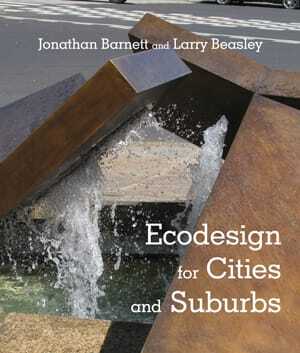Ecodesign for Cities and Suburbs
Jonathan Barnett and Larry Beasley
Island Press
2000 M Street, NW, Suite 650, Washington, DC 20036; www.islandpress.org.
2015. 304 pages. Paperback, $45.
Despite mounting evidence that a new urban growth model is needed, America continues to build dysfunctional cities and suburbs. Instead of resilient, accessible, and environmentally compatible settlements, the U.S. growth machine continues to turn out mostly vulnerable, sprawling, and ecologically destructive places. The authors of this ambitious book would reverse that practice with “ecodesign,” their approach to urban and suburban planning, regulation, and development.
Ecodesign practitioners see cities and their hinterlands as opportunities to integrate environmental soundness with human health and well-being. Their aim for city building and city management is to harmonize urban and natural systems. While this approach dates back to the pioneering work of Ian McHarg in his 1969 book Design with Nature, the authors broaden and update it, demonstrating both its necessity and its feasibility.
The proposed ecodesign framework contains four objectives: adapting to climate change and limiting global warming; balancing transportation modes; replacing outdated development regulations; and reshaping the public realm. Some urban areas successfully achieve elements of one or more objectives, but none brings all of them together into the city- or regionwide approach that the authors argue is necessary. They imagine future urban areas that are not just carbon neutral but “net positive,” adding to stocks of healthy natural resources.
This book’s strength lies in its wide-ranging descriptions of leading practice successes from around the world. Examples range from inexpensive zoning ordinance changes to billion-dollar high-speed rail system projects. The book is a veritable illustrated ecodesign catalog.
Barnett and Beasley are a good team. Jonathan Barnett, an emeritus professor of practice in city and regional planning at the University of Pennsylvania, has written many popular books on city design. Larry Beasley, a practice professor of planning at the University of British Columbia and a consultant, is the former co–chief planner for the city of Vancouver; his knowledge of Vancouver planning practice informs a great many of the book’s examples.
Adapting to climate change and limiting global warming are signature challenges of contemporary urban planning. Examples of adaptation include restricting development in known hazard areas before disasters and safer rebuilding after disasters, including artificial islands and reefs, landscaped berms, and parks that can double as wetlands. More grandiose solutions rely on protective gates to be raised in advance of a major storm. Examples of limiting global warming by lowering greenhouse gases include the creation of sustainable districts like Southeast False Creek in Vancouver and Hammarby Sjöstad in Stockholm, neighborhoods that use green
technologies, such as waste thermal energy capture and Leadership in Energy and Environmental Design (LEED) building standards, to reduce energy use and cut polluting emissions.
Balancing transportation modes demands new urban forms and facilities. To offset automobile use, suburban corridors can be restructured by turning obsolete commercial strips into land banks for mixed-use centers linked by bus rapid transit (BRT) systems. More affordable than fixed-rail systems, BRT systems move people as efficiently as light-rail transit at far lower capital costs. Toronto’s Big Move, a long-range transit system overhaul, is scheduled for completion in 2030 with 33 miles (53 km) of new light rail and 37 miles (60 km) of BRT.
Replacing outdated development regulations must undo a century of investment in traditional zoning. New regulation writers face existing ordinances that treat land as a commodity to be divided among uses rather than as a living ecosystem, that separate uses and densities rather than supporting natural urban complexity, and that base zones on arbitrary residential and commercial categories rather than on functional areas such as neighborhoods and business centers. Vancouver’s progressive policies provide for families with children in downtown developments, secure more low- and middle-income housing, and set transit-supportive density targets for its older neighborhoods.
Reshaping the public realm—streets, squares, and parks—is the most straightforward task, since it can be done on a project-by-project basis with both public and private funding. The principles are well known: emphasize small blocks, connect streets, define public space with buildings as outdoor rooms, highlight landmarks and wayfinding, and give pedestrians priority over cars. The reclaiming of Times Square for people by closing it to traffic and installing outdoor furniture is a leading example.
Despite its individual successes, wide-scale ecodesign implementation remains a hoped-for scenario. Thwarted by hostile national politics and divisions between the public and private sectors, significant change will depend on new forms of constituency collaboration among developers, local government, and consumers. The book offers innovative suggestions to satisfy the interests of all three parties.
“Discretionary and transactional” development management processes would broker neighborhood conflicts, reconcile settlement and ecology, and recognize the market value of land. The wealth from development would be marshaled to underwrite public amenities without touching necessary base profits. Given the political difficulty of adopting such negotiated processes and of the challenges to transforming isolated ecodesign successes into general practice, this is the most problematic part of the book.
Barnett and Beasley are optimistic, however, believing that their ecodesign vision will be supported by increasing public exposure to great projects, advances in technical planning and communication tools, and growing awareness of critical consequences. For them, the outcome will make us or break us as a species; adopting ecosystem principles will help ensure our survival. McHarg would surely agree.
David R. Godschalk is planning professor emeritus at the University of North Carolina at Chapel Hill and coauthor of Sustaining Places: Best Practices for Comprehensive Plans (APA Planning Advisory Service, 2015).





